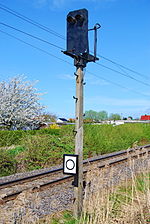Distant signal repeater

Germany
Distant signal repeaters are railway signals that stand between a distant signal and the associated main signal and announce the main signal again, i.e. repeat the distant signal. Main signals must be able to be recognized by the driver without interruption from a certain distance ( minimum visibility ). If this is not possible because of the obstructed view or if there is a risk of confusion with other main signals, e.g. if there are several main signals next to each other in a track curve, distant signal repeaters are set up. In addition, distant signal repeaters can be set up to speed up operations, for example if a main signal is difficult to see from a platform in front of it. Several distant signal repeaters can also be set up in very confusing places. An example from the Deutsche Bahn division can be found on the north-south route between the Fulda and Hünfeld stations . Here there are three distant signal repeaters in a tight arc. Only light signals are used as distant signal repeaters.
Originally, distant signal repeaters at the Deutsche Reichsbahn had the designation intermediate signal , which is not identical with the current meaning intermediate signal . In the signal book of the DR from 1959, these signals were listed as the main signal announcer , from 1971 they were omitted and were replaced by the distant signal repeaters still common today in the area of the former DR as hi-signals ; at the DB this happened as early as 1959 in the form of the Vr signals.
Signal aspect
The original intermediate signals were similar to the signal imitators still used in Austria today - they showed a main shape signal stylized by two light strips. If the main signal showed stop, a vertical white light stripe appeared on the intermediate signal, above it a horizontal white light stripe (signal Zs 1), showed the main signal driving, a vertical white light stripe appeared on the intermediate signal and above it a white light stripe rising diagonally to the right (signal Zs 2) . In the case of a speed limit on the main signal, a vertical white light strip was shown on the intermediate signal and, to the right, a white light strip rising from right to left (signal Zs 3).
The signals that were still used as main signal announcers from 1959 to 1971 at the DR showed the same signal patterns under the designations Ha 1 to Ha 3; in addition, at the DR from 1959 to 1971 as pre-signal repeaters, HI signals were given an additional white light.
Today's distant signal repeaters show since 1959 (DB) and 1971 (DR) the same signal aspect as the corresponding distant signal as a light signal; Supplemented with the H / V signal system by a white additional light on the left side of the signal screen at the level of the upper signal light, with the Ks signal system by a white additional light under the signal light, with the first Ks signals in the area of the former DR by an additional light white ring around the signal lights. You will not receive a pre-signal board and will not be announced by pre-signal beacons; with the HI signal system, however, they have a rectangular white board with a black ring and black border.
Austria
In Austria, the signal imitator is used on unclear sections of the route, which shows the position of the next following main signal by “imitating” a main signal as a signal image using lights. A signal copier can only show three signal aspects: “Main signal shows stop ”, “Main signal shows free ”, and “Main signal shows free with speed restriction ”. The extent of a speed limit is not displayed. The signal aspects are shown with white light bands or bars; If the term "main signal shows stop " lights up in yellow-orange light (the signal label is also framed in yellow), a 1000 Hz PZB magnet next to the signal mimic is active.
If the visibility demands it, several signal imitators are set up one after the other.
A signal imitator can also indicate that the substitute, caution or departure signal lights up for the associated main signal (white, red or green flashing light).
Switzerland
In Switzerland the distant signal repeaters are called repeat signals . The repeat signals are identical to the previous signals. In the case of the “N” signal system, the repetitive signals are marked with a white attachment with two black stars, provided it is purely an advance signal. With the signal system "L", however, they can only be recognized by the signal designation. The repeat signal of main signal A is labeled A **, while the distant signal is called A *. An asterisk is added to the signal designation for each additional repeat signal (e.g. A *** or N222 ****).
Individual evidence
- ↑ Railway Signal Regulations 1959 Status: December 9, 2012, p. 27. ( PDF, 0.8 MB ( page no longer available , search in web archives ) Info: The link was automatically marked as defective. Please check the link according to the instructions and then remove this notice. )
- ↑ Stefan Carstens: Signals 2: Signal aspects, arrangement and designs, main and distant signals, signal connections . 2nd Edition. MIBA-Verlag, Nuremberg 2007 p. 87, ISBN 978-3-89610-236-2 .


